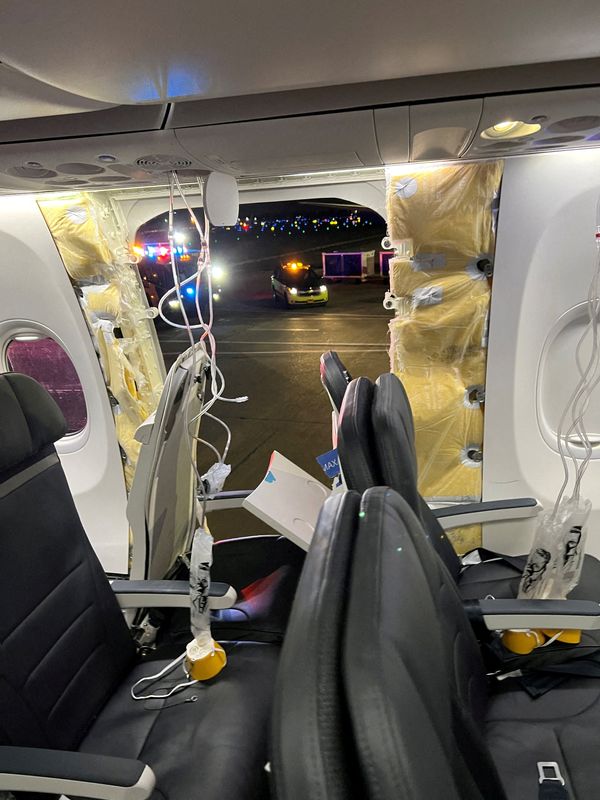By Valerie Insinna and Tim Hepher
WASHINGTON (Reuters) - A mid-air blowout has put jetmaker Boeing (NYSE:BA) in the exact place investors and management hoped it would avoid - back in the regulatory crosshairs just as it was awaiting approval of new models of its best-selling MAX jet.
Investigators say it is too early to determine what caused a so-called door plug to fall off from the side of an aircraft operated by one of Boeing's most loyal customers, Alaska Airlines, on Friday with 171 passengers on board.
The Federal Aviation Administration (FAA) said on Sunday that 171 Boeing MAX 9 airplanes BA.N would remain grounded until the agency is convinced they can safely operate.
The mishap comes as Boeing and supplier Spirit AeroSystems (NYSE:SPR), which made the panel, are grappling with ongoing production setbacks that have hampered recovery from an earlier lengthy 737 MAX safety grounding and wider disruption from the pandemic.
Boeing has been under pressure to expand the MAX portfolio and narrow a gap with rival Airbus, which has extended gains in market share since two Boeing MAX crashes in 2018 and 2019 that killed nearly 350 people and led to the MAX's worldwide grounding for 20 months.
The MAX's troubled history resulted in sweeping reforms of U.S. airplane regulation in 2020, and the Alaska incident could prompt regulators to take a tougher line on other outstanding issues.
Airlines increasingly want to carry more passengers in single-aisle aircraft to take advantage of increases in performance and range while benefiting from their lower cost.
After disappointing sales of the MAX 9, Boeing's largest narrowbody, the company was betting on its newest proposal, the larger-capacity MAX 10, to cut into runaway sales of Airbus's A321neo at the busiest end of the market. Analysts say a full rollout of the MAX line-up is crucial to help Boeing steady or improve its roughly 40% market share and generate enough cash to comfortably ride out the coming decade.
Boeing, saddled with $39 billion in debt, has been reluctant to invest in an all-new plane until engine technology matures in the next decade. Delays to certification of the MAX 10 in particular could put Boeing's 2020s-bridging strategy under renewed pressure, analysts said.
Boeing's struggles also come under the watchful eye of China, a key market broadly closed to the jetmaker in recent years as MAX safety concerns overlapped with trade tensions. Chinese officials sought updates on the Alaska incident on Saturday, sources said.
Both Boeing and Spirit declined comment.
Since the 737 MAX was grounded in March 2019, Boeing shares have dropped by more than 40% while Airbus shares are up 25%.
The first clue to the fallout will be how regulators treat certification of the smallest and least-sold version, the MAX 7, which is next up for approval, said Jeff Guzzetti, a former U.S. air crash investigator.
The FAA is evaluating whether to grant an exemption that would allow the MAX 7 to attain certification before Boeing completes required design changes. The MAX 9 accident could "swing the pendulum" toward a rejection, he said.
"The FAA needs to be seen as strong and on top of things and strict when it comes to safety," Guzzetti said. "The days of any kind of coziness are over."
The FAA said "safety will determine the timeline" of ongoing certification projects but declined further comment.
QUALITY ISSUES
Although it is too early to identify the cause of the blowout, experts said the investigation could rekindle a debate over recent quality problems if the a production issue was the root cause of the MAX 9 panel dislodging itself.
"How many production deficiencies and quality escapes do you need before you really start to consider how to wrap your hands around the whole process and cure all of it?" said Guzzetti.
Although Boeing's 737 manufacturing line has evolved, it was never intended to produce 750 aircraft a year, said Michel Merluzeau of AIR Strategic Advisory.
Boeing has introduced robotic systems into 737 manufacturing but is targeting bolder digital reforms in future programs as part of a growing battle over production strategy with Airbus, while still tackling supply chain and labor issues.
Past initiatives that put pressure on suppliers to cut costs, as well as a disconnect between top executives and engineering and manufacturing corps, have added to Boeing's difficulties, said Richard Aboulafia of AeroDynamic Advisories, a longstanding critic.
Recent 737 production setbacks include loose or missing hardware on the rudder system of two MAX jets, improperly drilled holes made by Spirit, and the incorrect attachment of brackets joining the MAX's aft fuselage to its tail.
In February, Boeing was forced to pause 787 Dreamliner deliveries after a data analysis error was found - a problem Boeing said was unrelated to previous issues that stopped deliveries between 2021 and 2022.
Boeing insists its patience is paying off.

"Our production system is poised for steady and efficient increases, but we won't push the system too fast and will ensure the supply base is in lockstep with us," CEO Dave Calhoun said in October.
(This story has been refiled to remove an extraneous word in paragraph 1)